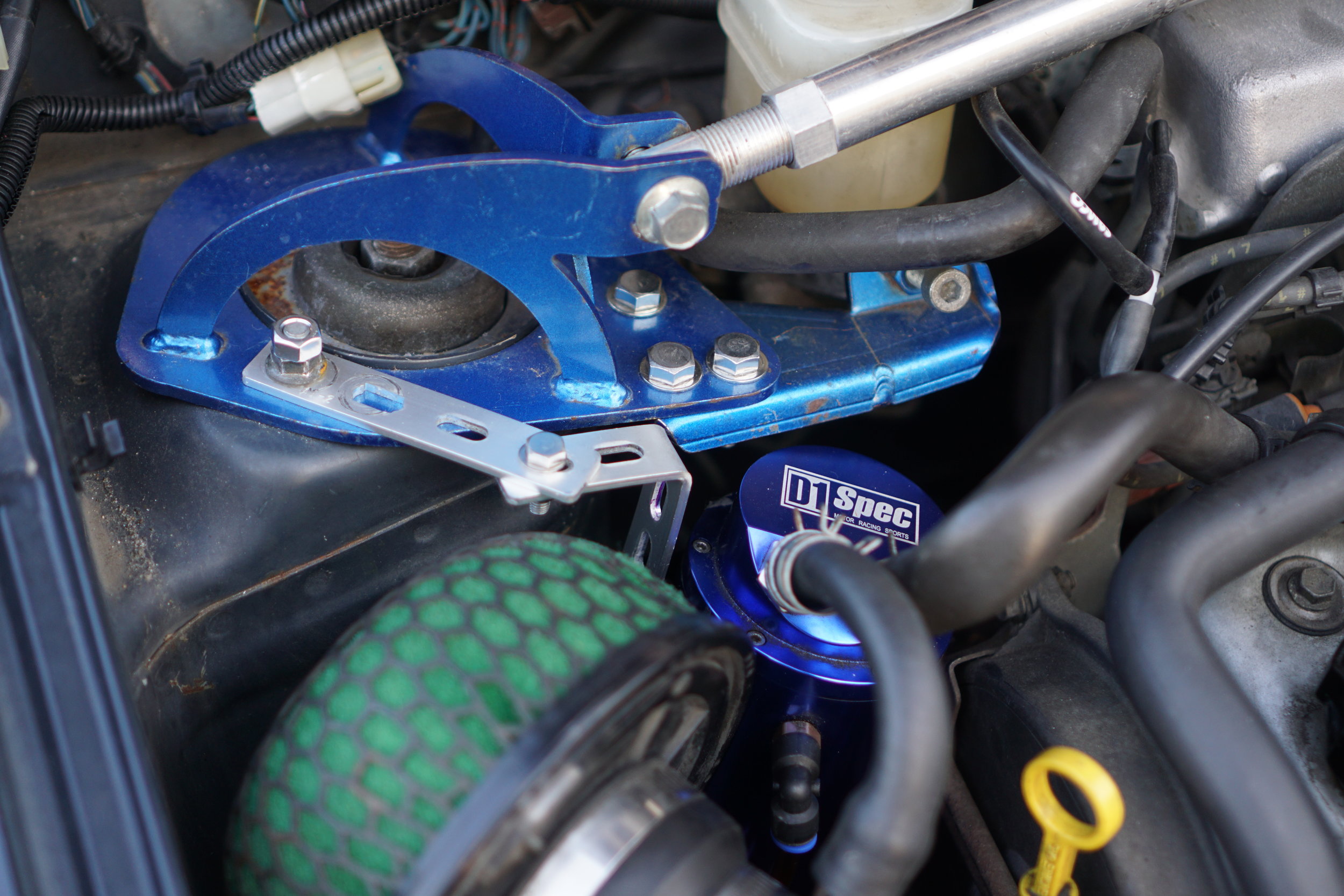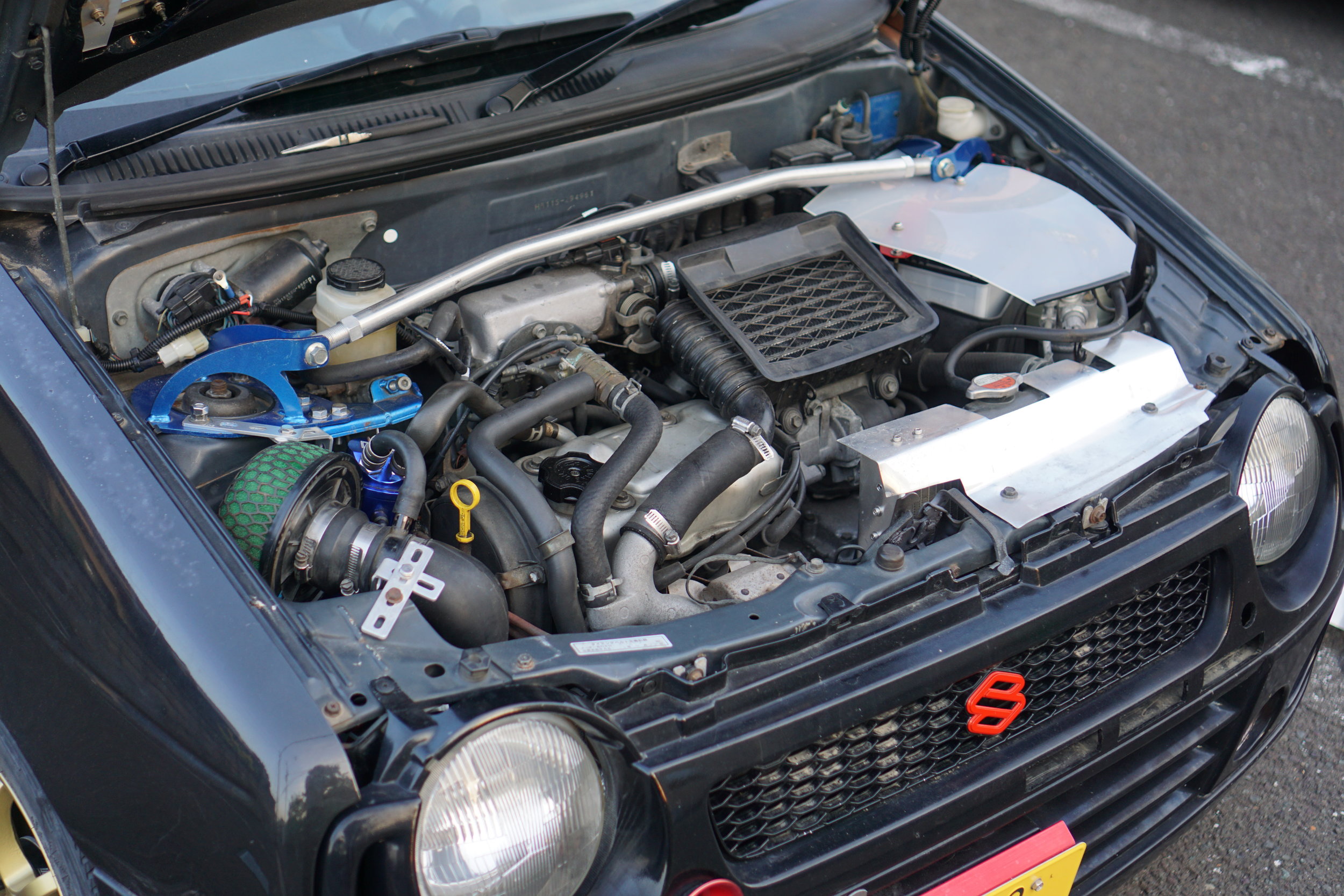[ Alto Works ] Cusco Front Strut Tower Bar (Performance Bracing, Part 2)
After running my car harder and harder, I was bound to need some help stiffening it more… As discussed in Part 1 , stiffening the chassis is a very important method of improving the road manners and performance of older cars. Not to mention, I just can’t leave well enough alone.
One of the first aftermarket modifications I made to my Mazda Miata Roadster was a front shock tower bar. (Any Miata purist will be sure to tell you that the suspensions are shock absorbers rather than MacPherson struts. Yes, there is a real difference, but let’s just save that discussion for a different time.) While it didn’t make any noticeable difference in driving dynamics that I could tell, the perceived difference was actually quite significant.
The Alto Works front suspension design is drastically different than the Roadster, though, as it is a very simple MacPherson strut setup. Typically, such designs would benefit from stiffer sways, front strut bars, and a stiffened front chassis in order to limit deflection and geometry changes, increasing predictability and handling sharpness. Most STB connect the tops of the struts (hence, the strut descriptor), so when a force is applied to one end of the strut, the load can be evenly distributed across the whole chassis, reducing drastic flex and keeping the car controlled.
I picked up this used Cusco Front Strut Tower Bar with a Brake Cylinder Stopper for a very reasonable 8000¥ ($74 USD) off of Yahoo! Auctions Japan. The price of a used STB typically starts around 3000¥depending on brand and condition, but I opted to more than double the cost for a Cusco one with the aforementioned BCS. (More on that later.) However, even at the price I paid, it is still half of the retail price or the lowest price of a new part I could find on the internet.
It arrived a few days after with the shipping cost Cash On Delivery (COD). This is actually pretty common in Japan, since it allows sellers to simply hand over the sold item to the delivery company (in this case, Kuroneko Yamato Transport) and let them handle wrapping and packing, shipping, and obtaining the delivery fee from the receiver. This alleviates the work for the seller but this makes it difficult to determine for the buyer the shipping fees. And the buyer has to have cash when the delivery person shows up; I almost didn’t have enough on me at the time. Overall, it’s a good system, especially since the delivery fees are rather reasonable in general.
While the surface had some minor surface rust and paint wear on the strut mounting plates, it is still in very usable condition. In hindsight, I should have cleaned it up a bit more before proceeding with the install, but I was excited to get it on and tested in the limited daylight after work.
To a stock, unmodified Alto Works, this is a literal four-nut drop-in fit, but as you can see, my engine bay is a bit more crowded. I have a few more things I need to redo to accommodate the bar: The intake heatshield and plastic battery cover need to be trimmed to allow some clearance.
Not a difficult job, but then I noticed my oil catch can was rubbing up against the BCS. This had to be repositioned and new holes filed out, but now it seems to be about perfect.
Brake Cylinder Stopper
Speaking of the Brake Cylinder Stopper, these things have definitely been the best upgrades I have ever made to my cars. A BCS increases pedal stiffness when the pedal is fully pressed, making the brakes feel like they bite harder and eliminating a lot of slop or vagueness. The feel is so dramatically different that it almost feels like a whole different car.
How this simple metal plate and screws have such a positive effect is simple; they push against the brake master cylinder (MC) and prevent it from moving when the brake is depressed. The MC increases and multiplies pedal pressure when you apply the brakes, making modern brake systems significantly more effective than older non-boosted brakes. Since the MC is attached to the firewall, under pressure it presses against the metal wall, potentially causing flex and visible movement. Albeit minor, this movement increases pedal travel, softens feel, and reduces brake effectiveness.
To see this flex yourself, have someone stand on [apply full pressure] on the brake pedal when the car is parked and engine idling. You can often see movement in the brake MC, pushing forward into the engine bay, if even for a few millimeters.
Now a BCS may not beneficial for all cars, of course. Newer cars have a stronger, thicker firewall to help aid in stiffness, limit engine noise, and improve protection, but older cars and kei cars often use the thinnest, lightest, cheapest materials which means noticeable flex. Those are the cars that can see the greatest benefit from such a mod.
Almost immediately, I could tell a difference in the pedal feel. The brakes, already with a stiff travel, feel even harder when fully applied, giving me full confidence in braking. Now, if only I had ABS, too…
Conclusion
After driving with the bar installed for a few days, I can definitely feel some improvement in turn-in and general road manners. Like with my spring cut modification a few months back, it marginally makes the car feel like it has even more understeer than before. I surmise this is due to the additional front stiffness. Whether this is desirable or not at this junction is debatable, but most beneficially, the car absorbs bumps much more solidly, with the car and the interior creaking less on rough roads.
A worthwhile shot of Viagra to my front end. *snicker*
The next major performance / bracing modification should also prove quite useful in other ways! What do you think I have lined up?








